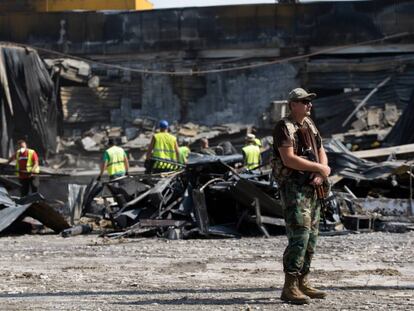Western sanctions on Russia: How well are they actually working?
Although the reprisals for the invasion of Ukraine are not causing serious damage to Russia’s economy, it is undergoing a clear contraction

One question is hovering over the international political scene: are the sanctions imposed on Russia by Western democracies for the invasion of Ukraine working? While some data show that the sanctions have seriously hurt the Russian economy, others indicate that the blow has been minimal. Meanwhile, after initial setbacks, the Kremlin’s war machine is advancing on the battlefield, while rampant inflation is shaking Western societies. There is no objective and definitive answer to this question, but there is a lot of data that can provide some insight.
The Russian economy is undergoing a clear contraction: the annual inflation rate hovered around 17% in May; in the same month car production was down by 97%, compared to the previous year. Reserves of the Russian Federation in foreign currencies worth around $300 billion are blocked in accounts under Western jurisdictions. Several signs point to a brain drain in important sectors like information technology. A few days ago, the Kremlin was not able to meet a debt interest payment, defaulting for the first time in a century. Imports are very depressed; and hundreds of foreign companies have left the country of their own accord.
But at the same time, Russia is reaping extraordinary profits from the sale of fossil fuels, thanks to the high prices and to increased purchases from China and India. It has managed to stabilize its currency after initial setbacks, avoiding a collapse of the financial system. Both gross domestic product (GDP) and inflation forecasts have improved significantly from a couple of months ago; and unemployment is at its lowest since the dissolution of the USSR. The Kremlin is no doubt pleased by the tremendous turbulence caused in the West by the skyrocketing energy and food prices, as well as the disruption of several supply chains.
In the long term, the impact of sanctions will depend on how soon Russia manages to establish new routes with non-aligned countries, and whether China or India will be willing to support a partner in need by risking secondary sanctions, which is unlikely, according to Maria Shagina, a researcher on economic sanctions at the International Institute for Strategic Studies. The Russian economy will not collapse, says the expert, but the country will be more isolated.
This is the overall picture of an economic battle with far-reaching consequences. Around 40 countries, representing more than half of the world economy, have adopted different types of sanctions against Russia. The main ones affect the energy sector (the bans on the purchase of fossil fuels), the financial sector (the freezing of assets and reserves and the exclusion of several Russian entities from the SWIFT system), the trade sector (the ban on selling Russia products with strategic technologies or buying gold), and the transportation sector (the veto on flights from Russian territory). This situation not only affects the specific countries involved, but also has global repercussions. Here is an explainer of how the sanctions are affecting the main sectors.
Energy
Are the energy sanctions working? The answer is no, according to Simone Tagliapietra, an analyst specializing in this matter at the Bruegel think tank, because so far Europeans have not done anything other than announcing measures. The coal ban will take effect in August; the ban on oil imports by sea, at the end of the year. According to Tagliapietra, Europe’s hesitation – its announcement of future measures instead of immediate action – is a strategic mistake. Crude oil prices have risen, China and India are importing more than before, Europeans have not reduced imports by much, and the Russians are gaining. As for gas, while the Europeans have not had the courage to do something, the Russians are taking action, restricting supplies to several European countries.
A study published in mid-June by the Center for Research on Energy and Clean Air noted that Russia made close to €93 billion from fossil fuel exports in the first 100 days after the invasion, of which some €57 billion were purchased by the European Union. European spending, Tagliapietra points out, continues, and that figure is now close to €66 billion. Bloomberg indicates that India’s energy imports from Russia between March and May increased fivefold, compared to the same period of the previous year; China has doubled that value.
In this context, the Kremlin has been able to mitigate the impact of the sanctions on its economy by having a fund for social protection and stimulus measures. GDP contraction forecasts had reached -12%, and now Russian leaders are beginning to point to a milder margin of -3% to -5%. Finance firm JPMorgan places the 2022 recession at around -3.5%. Others mention higher figures, but most experts have a favorable forecast. At the same time, energy bills are skyrocketing in the West, causing social unrest, and governments are bending over backwards to ease the impact of the rising cost of living. The recent G7 summit, held in Germany, made clear that something is not right in this sector by focusing on an alternative sanction system: price caps.
The idea seeks to reduce Russian income without causing a huge disruption in the global energy markets, where Russia is a major exporter. The concept contemplates extending the application of the cap by vetoing access to Western insurance or transportation services to those who do not respect the established threshold. The administration of US President Joe Biden, which worries skyrocketing gasoline prices will sway voters at the midterm elections in November, is pushing in this direction.
That is one of the key playing fields. Most analysts believe that India and, above all, China, would not be willing to hurt their trade relations with the West in order to save Russia. Beijing, in particular, is so closely interconnected with Western economies that it is unlikely to risk these trade relationships for the sake of Moscow.
Production and trade
Russia is no longer publishing its import data, but the export statistics of 54 countries that accounted for 90% of all Russian purchases in 2021 show a complicated situation for the Kremlin. Not only has trade from sanctioning countries fallen by 60%; there has also been a 40% drop from countries that have not applied sanctions.
This means that the sanctions are considerably reducing Russia’s capacity to supply itself. There does not seem to have been any readjustment process whereby, in the absence of Western products, an equivalent supply chain from other countries has been built. Significantly, China is in line with that trend. If its imports from Russia have increased due to its larger energy purchases, its exports to Russia have shrunk in a way that is comparable to that of other countries. Beijing is not filling gaps.
Russia is an economy with a strong dependence on foreign countries in many sectors, particularly in technology, compared to the West, says Shagina. Import substitution, she points out, has failed, and now the only hope is to establish new supply chains through parallel imports via third countries, but they will be of inferior quality, more expensive and overall more cumbersome.
The US Department of Commerce maintains that global exports of microchips to Russia have fallen by 90% since the invasion. The dismal car production data could be a sign of the difficulties in accessing the necessary components. The aviation sector is also having difficulty overcoming the impact of the sanctions.
In the energy sector, the situation is especially problematic for Moscow. The export ban on key technologies, the voluntary stampede of leading Western companies that used to operate in the sector in Russia and the adverse market scenario, are all having an impact. An internal document from the Russian Ministry of Economy, to which Reuters had exclusive access, placed the contraction in crude oil production for this year at 17%. Official estimates for the gas sector point to a reduction of 5%.
Some analysts believe that this erosion of productive capacity will worsen over time, spreading throughout an economy with a limited spectrum of activities, and that it will therefore have difficulties adapting locally. This problem may also affect military manufacturing.
Finance
In this sector, Russia has managed to withstand a very strong blow. The ruble suffered a sharp drop, and the prospect of the exclusion of Russian entities from the SWIFT international banking circuit came very close to unleashing a wave of panic. However, skillful interventions by the Central Bank of Russia managed to stabilize the financial system; there are no longer rumors of bank stampedes, inflation is dropping and the ruble has strengthened, notes Shagina. The entity adopted a sharp rise in interest rates and other currency control measures that pushed the ruble back to its best levels against the dollar in seven years.
The Russian financial system has stabilized, and it is now facing a plethora of non-existential problems that impact its functioning. The lack of access to certain technologies hinders the smooth development of certain operations, although the most worrying sign for Moscow is undoubtedly the non-payment of a due date at the end of June. This occurred not because of a lack of funds – and for this reason, the Kremlin insists that it is not appropriate to call it a default – but because of the obstacles of sanctions. If repeated, it would obviously inflict serious damage on Russia in the credit markets.
In this sector, as in others, the struggle goes on. The US and other countries have just imposed a ban on gold imports. Western leaders are determined to hold their own for as long as it takes, the G7 said. But it is clear that, in the case of the EU, for example, in each round of sanctions – so far there have been six – reaching a consensus has been harder. This is a fight that requires both intelligence and willpower to resist adversity.
Tu suscripción se está usando en otro dispositivo
¿Quieres añadir otro usuario a tu suscripción?
Si continúas leyendo en este dispositivo, no se podrá leer en el otro.
FlechaTu suscripción se está usando en otro dispositivo y solo puedes acceder a EL PAÍS desde un dispositivo a la vez.
Si quieres compartir tu cuenta, cambia tu suscripción a la modalidad Premium, así podrás añadir otro usuario. Cada uno accederá con su propia cuenta de email, lo que os permitirá personalizar vuestra experiencia en EL PAÍS.
¿Tienes una suscripción de empresa? Accede aquí para contratar más cuentas.
En el caso de no saber quién está usando tu cuenta, te recomendamos cambiar tu contraseña aquí.
Si decides continuar compartiendo tu cuenta, este mensaje se mostrará en tu dispositivo y en el de la otra persona que está usando tu cuenta de forma indefinida, afectando a tu experiencia de lectura. Puedes consultar aquí los términos y condiciones de la suscripción digital.
More information
Últimas noticias
Half of Scotland is in the hands of 420 property owners
Reinhard Genzel, Nobel laureate in physics: ‘One-minute videos will never give you the truth’
Pinochet’s victims grapple with José Antonio Kast’s rise in Chile
From digital curfews to blocking apps: How technology experts protect their children online
Most viewed
- Pablo Escobar’s hippos: A serious environmental problem, 40 years on
- Reinhard Genzel, Nobel laureate in physics: ‘One-minute videos will never give you the truth’
- Why we lost the habit of sleeping in two segments and how that changed our sense of time
- Charles Dubouloz, mountaineering star, retires at 36 with a farewell tour inspired by Walter Bonatti
- The Florida Keys tourist paradise is besieged by immigration agents: ‘We’ve never seen anything like this’











































